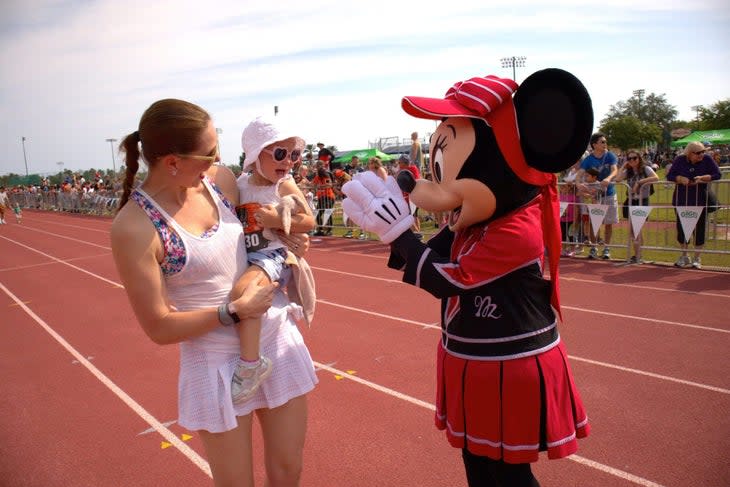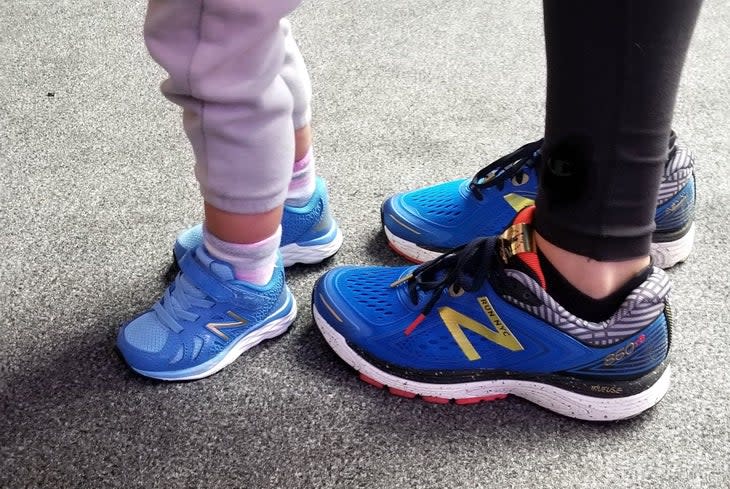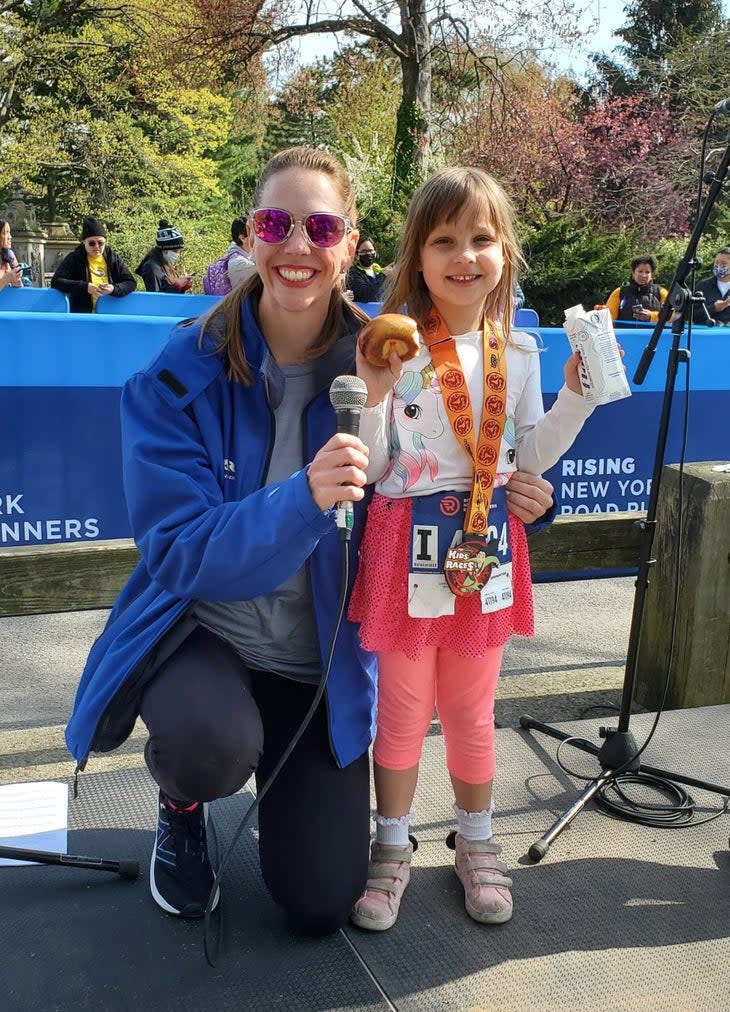Running With My Daughter Allows Her to See Who I Am
This article originally appeared on Womens Running
"Ready, steady, go!" My 5-year-old daughter shouts before peeling off down a New York City sidewalk. Most days, as we walk nearly a mile to and from school, we race in one-block chunks. If she presses her "magic" hair clip, she gets a burst of super speed that leaves me in the dust. Some days, I jog nimbly beside her on fresh legs. Other days, I struggle to keep up if I'm recovering from a hard workout. And sometimes she rings an imaginary bell. "Ding, ding, ding!" she calls, breathing heavily. "Break time!"
In these daily sprints, I am simultaneously a competitor and play-by-play announcer. "Daisy Daffodil is off to an early lead, looking strong and relaxed," I say of her favorite alter ego. "She pulls away from the field. It's like she's found another gear! Karla struggles to hang on. She's falling off the back. Daisy barrels into the finish line... and she's done it! Daisy Daffodil Grapefruit wins!"
As a longtime runner, fitness writer, and race announcer for dozens of events like the TCS New York City Marathon, running is my life. But over the years, the sport has become our lives. Since her earliest infancy, my daughter has watched me emcee races on weekends, traveled with me to events I'm running, or toed the line herself. Running has been a huge part of her childhood.
She "ran" her first race--a diaper dash at Walt Disney World--at 12 months old. She happily toddled through it and a few more events in the following years.

But then the pandemic struck. I didn't work as a race announcer or run a major event for 16 months.
But my daughter and I kept running together. We ran at the park (especially when playgrounds were shuttered), on the sidewalk, anywhere she could find enough runway. It was during these months that she went from favoring a stroller to preferring her own two feet. After all, what's the best way to get from point A to point B when you're a kid? Run! We leaned into it. I watched her stride morph from jiggly and jangly, to smooth, efficient, and effortless.
After a 3 year break, my daughter finally toed the line again at a Rising New York Road Runners kids event that I was working. She was beyond excited to have me as her announcer at a real race instead of our daily dashes down the sidewalks of New York.
She squealed when I told her.
But when the excitement wore off, she got nervous. "What if I fall? What if I hurt myself? What if I don't win?" She peppered me with questions. "If you fall, you'll get back up," I told her. "You know how many races I run. I never win! But I have a lot of fun and feel proud of my accomplishments." We addressed her fears one by one. After all, evidence shows that taking healthy risks, normalizing failure, and teaching perseverance are the keys to building confidence. Sports (and other activities that push us out of our comfort zones, like debate team or activism) are one surefire way to experience that process of struggle and mastery, according to Claire Shipman, Katty Kay, and Jillellyn Riley, co-authors of The Confidence Code for Girls.
“Sport is simply an organized and easily available opportunity to experience loss, failure, and resilience,” Shipman, Kay, and Riley wrote in an article published in The Atlantic.
RELATED: 3 Pro Runners and the Fast Women Who Raised Them
Some groups like the Women's Sports Foundation, founded by Billie Jean King, see sports as a key to achieving equality on a global scale. The United Nations even included sports as a catalyst for gender equality in its Sustainable Development Goals. Research confirms that girls who participate in sports have higher self-esteem and confidence, more positive body image, lower levels of depression, and lower rates of drug use. When it comes to academics, they also get better grades, attend more school, have greater college aspirations, higher graduation rates, and lower risk of disciplinary action.
They're more likely to be leaders later in life, too. Some 94 percent of women who hold C-suite positions like CEO or CFO played sports, according to a report by EY and espnW. To appreciate just how staggering that statistic is, consider this: only 31 percent of girls aged 6-12 and 56 percent of teen girls participate in sports. And just 6 percent of the 3.5 million female high school athletes go on to play in the NCAA. An astonishing 52 percent of female CEOs are former collegiate athletes.
They are in rare company. As of 2021, women represent just 5.6 percent of CEOs in the Russell 3000, an index that tracks 98 percent of tradable stocks in the U.S. Fewer women overall than men named "James" serve as CEOs of Fortune 500 companies, according to a 2018 New York Times report. More men named "John" than women are Republican senators; the same goes for Democratic governors. This is despite the fact that Johns are just 3.3 percent of the male population, while women account for 50.8 percent of the total population. Yet a 2019 report by S&P Global analysis found that female CEOs actually outperform their male peers, driving higher value appreciation and stock performance for their companies.
By and large, most of the women breaking through these glass ceilings are athletes. After all, sports and other competitive activities can teach more than just confidence, including problem-solving, team-building, critical thinking, time management, self-discipline, determination, resilience, leadership, and more--all skills that the workplace rewards.
"We both realized very clearly during the course of our research and numerous interviews with neurologists, psychologists, and educators that something happens when girls play sports," Kay told EY and espnW. "Playing competitive sports embodies the experience not just of winning, but the experience of losing. The losing is almost as critical. When you're playing sports and you do badly, you have no choice but to pick yourself up and carry on. That process really builds confidence. It's an incredibly useful proving ground for business and leadership."

Of course, I'm not necessarily priming my daughter to be a CEO or Olympic athlete. I want her to find her own passions and strengths, whatever they may be.
But as a pre-schooler, she emulates what I do. Modeling for your child can be challenging and anxiety inducing. (Am I doing it right? What if I do it all wrong? What am I subconsciously saying when I do this or say that?) But running makes it easy. She sees me leave for training runs day-after-day. She watches me struggle, she sees me triumph, witnesses my perseverance. She learns about dedication, hard work, and resilience.
She was there when I collapsed in tears of joy after nailing the sub-2 hour half-marathon I'd been chasing for a decade. She was there when I dropped out of my big goal marathon last fall. I pulled off the course when I saw her and my husband at mile 19, and announced I was done. She held my hand as we walked to the car, where she offered me a donut. A stale powdered donut never tasted so good.
RELATED: Arielle McKenzie Could Be a Once in a Generation Running Sensation
Then she watched me lace up once again in the aftermath.
"Momma, how was your run?" she always asks when I come home. Sometimes it was great. Sometimes it was tough. I try to give an honest answer every time to normalize the ups and downs of life.
The sport helps my daughter see who I am, what I do, and what I love. She sees that it's important for adults to take care of themselves and others, too. She sees me cheer on runners when I work as a race announcer--a job that has been one of the greatest joys of my life. You'll often find her with pom poms at the races I work, shouting, "Go, runners, go!"

When it was her turn to finally race again, my daughter arrived in Central Park wearing her prized pink Sparkle Athletic running skirt and one of the runDisney Kids Race medals she'd earned years earlier. I smiled. I pulled her on stage with me to root for the kids in the earlier corrals. She brought her pom poms for the occasion, of course.
"Whoo-hoo!" she shouted into the mic.
When her heat neared, I kissed her goodbye and watched her nervously walk to the corral with her dad. I could see the apprehension in her eyes and body language. It was my turn to fret. Would she break down crying and refuse to run? Would she fall and never want to race again? Would she be too hobbled by fear?
The starter yelled, "Go!" and all my worries washed away. She barreled lithely toward me, loose hair flying behind her. When I called her name, she flashed a big smile. She ran up to the stage with her post-race bagel and ribbon, excited and proud. She took a risk, succeeded, and earned a notch in her confidence belt.
I've come to realize--whether it's a daily dash on the way home from school or a special event on the weekend--I don't just run with my daughter. I run for her. So she can have the confidence to be anything, anyone, anywhere she wants to be.
RELATED: Born to Run--Or Are They? Here’s a Guide to Kids and Running
For exclusive access to all of our fitness, gear, adventure, and travel stories, plus discounts on trips, events, and gear, sign up for Outside+ today.

